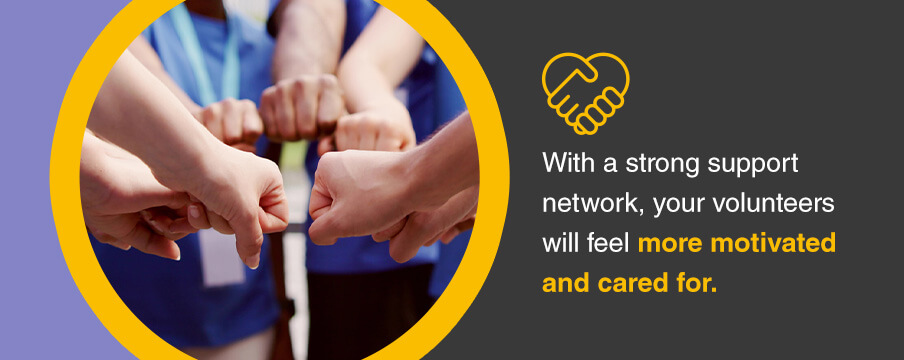Is there a reason you’re losing volunteers? If you’ve noticed that people aren’t coming back, you may wonder if the exits reflect on your nonprofit. Sometimes, you can address the reasons volunteers quit at an organizational level, and sometimes, there may be personal issues you cannot resolve.
Formal volunteering rates dropped between 2019 and 2021. While people are still willing to lend a hand, they’re less likely to do it formally and stick to it. While attracting volunteers is important, it’s also essential to figure out why volunteers quit. Knowing why volunteers leave can help you improve your retention strategies, encouraging volunteers to keep working.
Here are five of the top reasons why volunteers leave — along with some solutions you can use to help keep them around.
1. Lack of Time
There are only so many hours in the day, and between work, family, school, and other commitments, everyone stays busy. Volunteers often stop helping out because they lack time. They may want to help, but they have to choose between coming to one of your events or visiting a parent in an assisted living facility. Rightly, the parent will win every time.
The solution: Offer shorter shifts for volunteers. Almost anyone can fit a half-hour to an hour session into their schedule. Let volunteers pick their shifts — this ensures they’re only taking on as much as they can. Shorter shifts let volunteers get work done without it taking over their lives. You can still offer longer shifts, but you need balance to accommodate all your volunteers.
How Volgistics can help: Create a series of short schedule openings and allow volunteers to schedule themselves. They’ll be able to pick up one or more in a row, depending on how much time they have. Volgistics makes scheduling simple, reducing the strain on volunteers. Instead of trying to swap long shifts through text, they can easily manage their schedules from one convenient location.
2. Confusion Over Volunteer Duties
No one likes to feel as though they’re doing a poor job. When volunteers do not receive enough guidance or feedback, they can get frustrated. They don’t understand what to do, and they may not want to come back because of it. Volunteer resignation may happen simply because of poor communication. Maintaining an effective volunteer organization takes good communication. If no one knows their roles, how can they perform them effectively?
The solution: Provide a written summary of duties expected from a volunteer position, and meet with the volunteer before they begin to make sure they understand what’s expected of them. Having a concrete role with expectations gives volunteers a solid framework. They’re less likely to resign from a volunteer position they understand than one that’s confusing and undefined.
How Volgistics can help: Add details about each assignment in Volgistics. Volunteers can access it through clickable links on the schedule or your Opportunity Directory. You can use the checklist to ensure volunteers see a description as part of the onboarding process.
3. Insufficient Organizational Support
When something goes wrong, a volunteer wants to know they can bring the problem to you and receive support and guidance. If they instead get someone pointing the finger at them, they’ll no longer want to spend their free time with your organization. From inter-volunteer struggles to a difficult task, volunteers rely on you for support. Questions, concerns, and conduct all need to be established through your organization. If volunteers feel like they can’t rely on you, they might leave.

The solution: Welcome feedback and suggestions from your volunteer crew. Implement their good ideas and tell people where the new adjustments came from. Show compassion when volunteers run into problems. Let them know you care and are willing to help them through anything. With a strong support network, your volunteers will feel more motivated and cared for.
4. Missing Public Kudos
Everyone wants to feel loved and appreciated. When employees are not shown the proper appreciation, they can become disengaged. The same is true for volunteers. This feeling may prompt them to leave you. Volunteers work hard for your operation — doing long-term, demanding volunteer work can be challenging both physically and emotionally. When volunteers start to lose passion for their work, your operation will become less effective.
The solution: Tell people how much you appreciate their efforts. Better yet, show them. Buy them a gift card to a local coffee shop, or write them a heartfelt thank you note. Organize regular volunteer events or set up an awards ceremony. Volunteering is hard work, but you can motivate your team with a little love. By acknowledging their contributions to the company, you show them how much you value their contributions and how critical they are to the organization.
How Volgistics can help: Send out personalized email messages to your volunteers or show a custom greeting card when they sign in at VicTouch. You can also establish awards for volunteer milestones or a volunteer of the month. Volgistics lets you show support for your volunteers through effective communication strategies, encouraging them to stay motivated. Make it simple to reward your team for their hard work with Volgistics’ convenient solutions.
5. Burnout
If your nonprofit demands a lot from its volunteers, they may complain of burnout, which could lead them to quit. Dealing with highly emotional topics can take a toll on volunteers. Likewise, if they start by coming in 10 hours a week, they may find that it’s too much. Instead of pulling back, they could choose to leave altogether.
The solution: Look for signs of burnout in your volunteers — such as canceling shifts or appearing listless — and address them head-on. Ask if they need a break or could use assistance. Even just listening to them talk can encourage them to stay. Additionally, get strategic with your scheduling. Try to schedule volunteers for shorter shifts and spread those shifts out. Many volunteers have other jobs and responsibilities, so overscheduling them can feel overwhelming.
How Volgistics can help: Use the checklist feature to remind you to check in with volunteers regularly and keep track of when you’ve done so. Use scheduling software to create schedules that work with your volunteers’ lives. Create open shifts and give volunteers the chance to sign up for the ones that work for them. Having set schedules with some flexibility minimizes burnout and gives your volunteers more control over their lives.
Boost Volunteer Retention With Volgistics
Boosting volunteer retention is essential for your organization’s success. By instituting solutions to common issues for volunteers, you can reduce your turnover rate. Volgistics offers your operations the perfect solution. With volunteer management systems, you can streamline operations and keep volunteers engaged.
Using Volgistics lets volunteers participate in scheduling, communication, and progress tracking. With better organization and convenience, you can create a stronger connection between your mission and your volunteers. Contact us today or schedule a free demo to learn how Volgistics can transform your volunteer retention!


